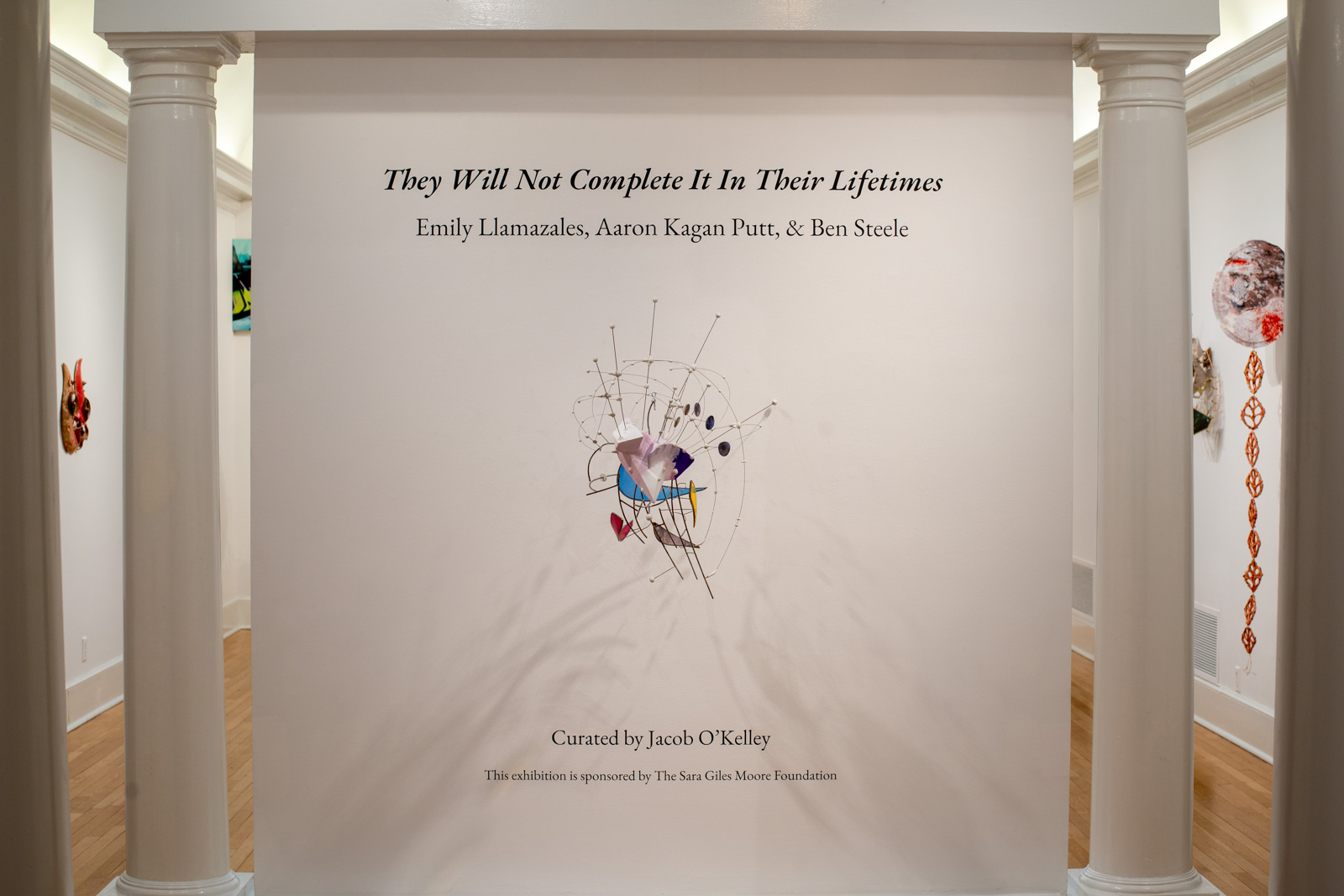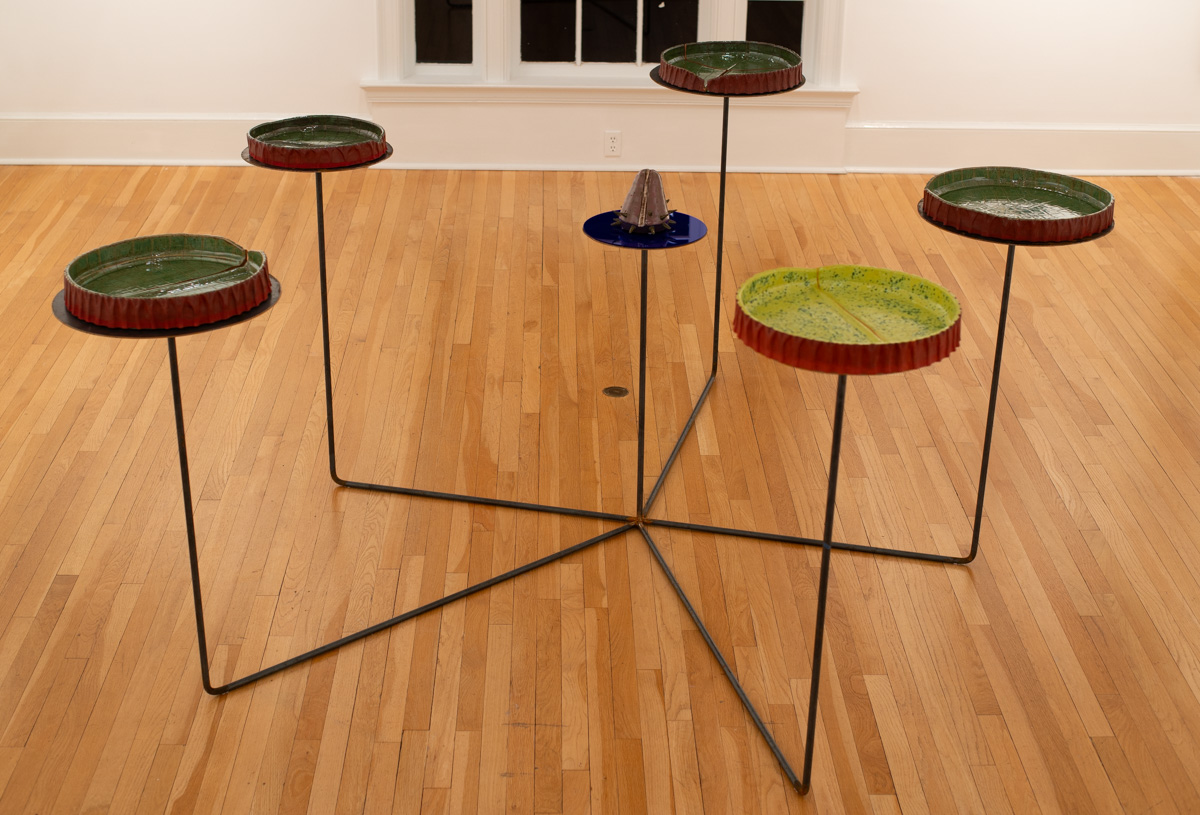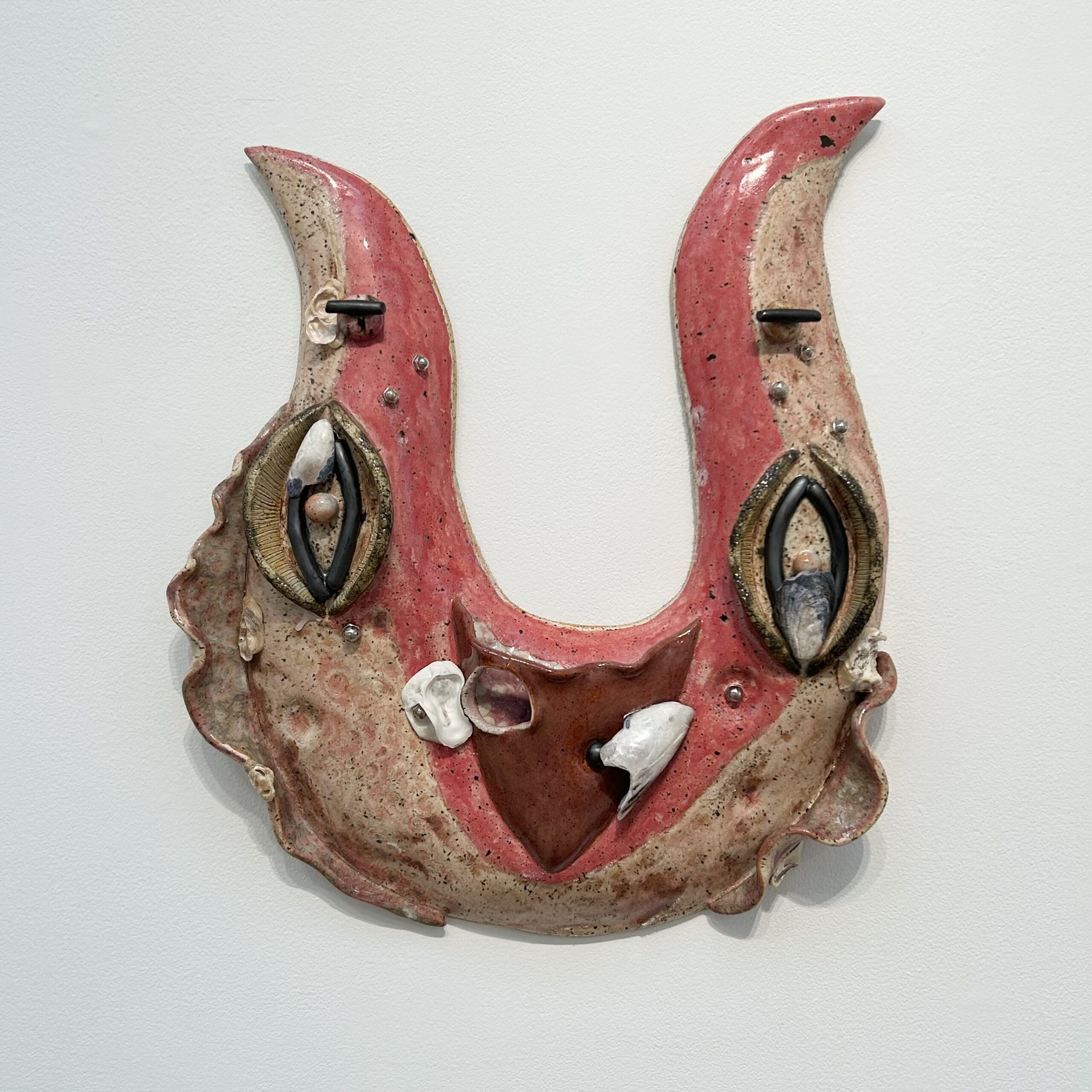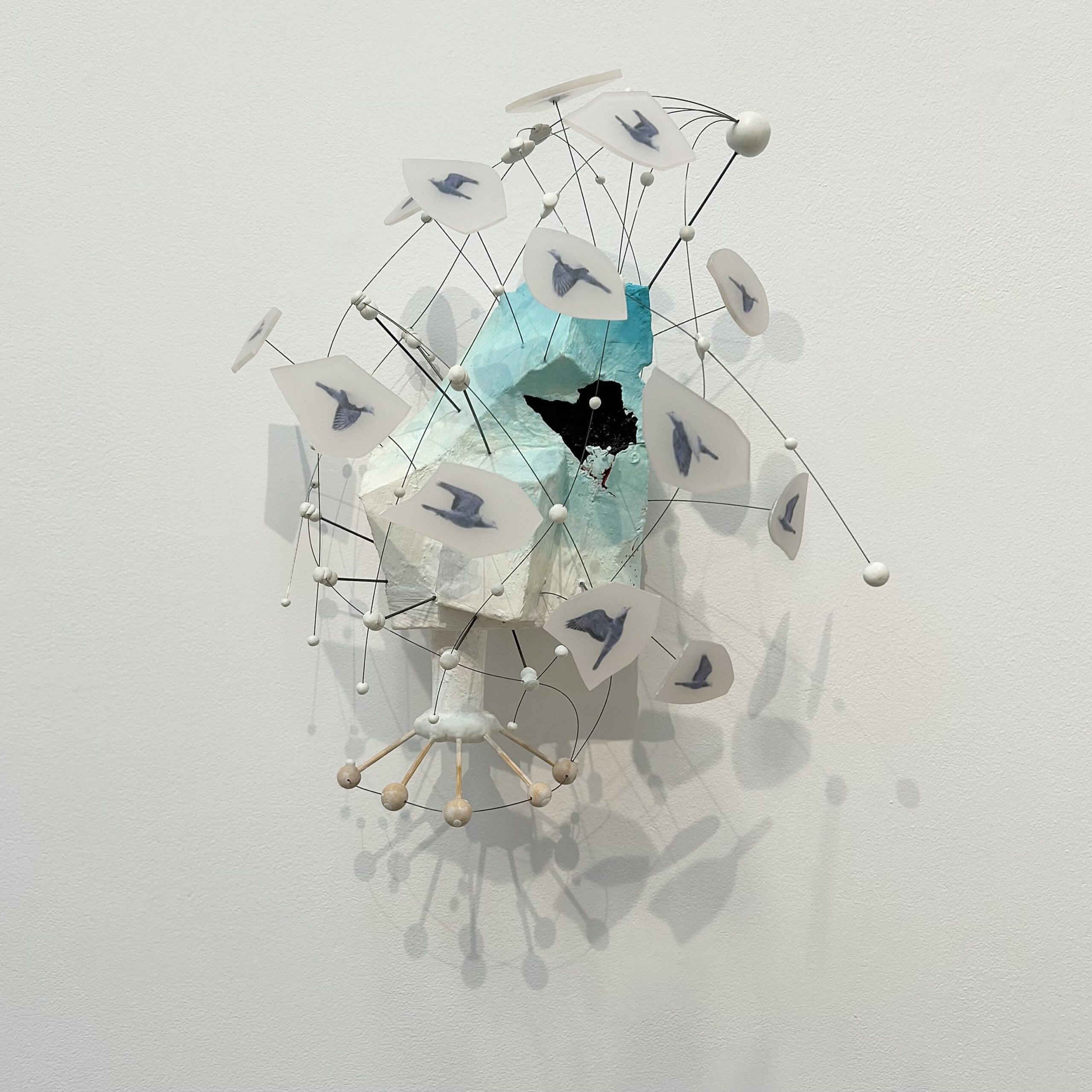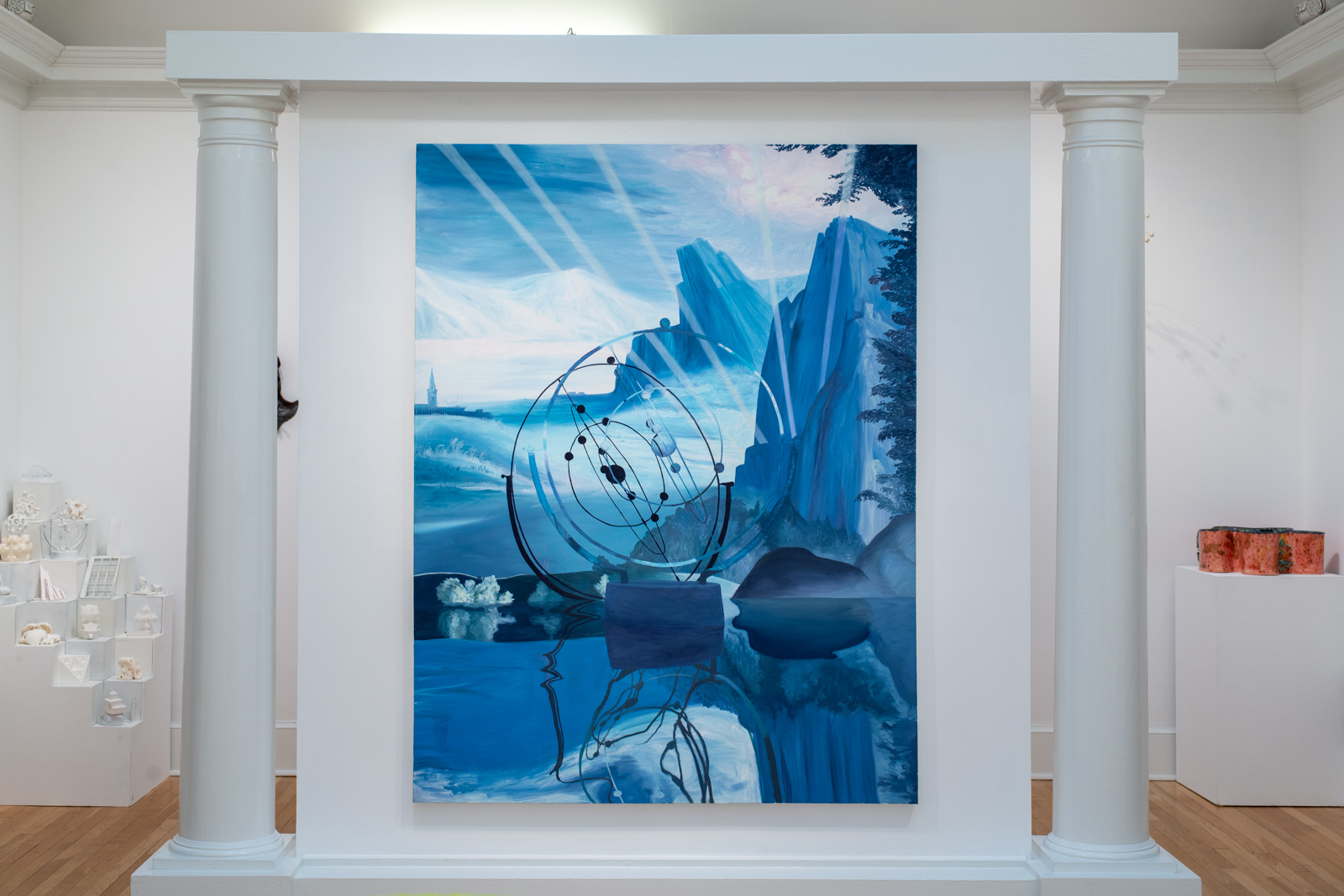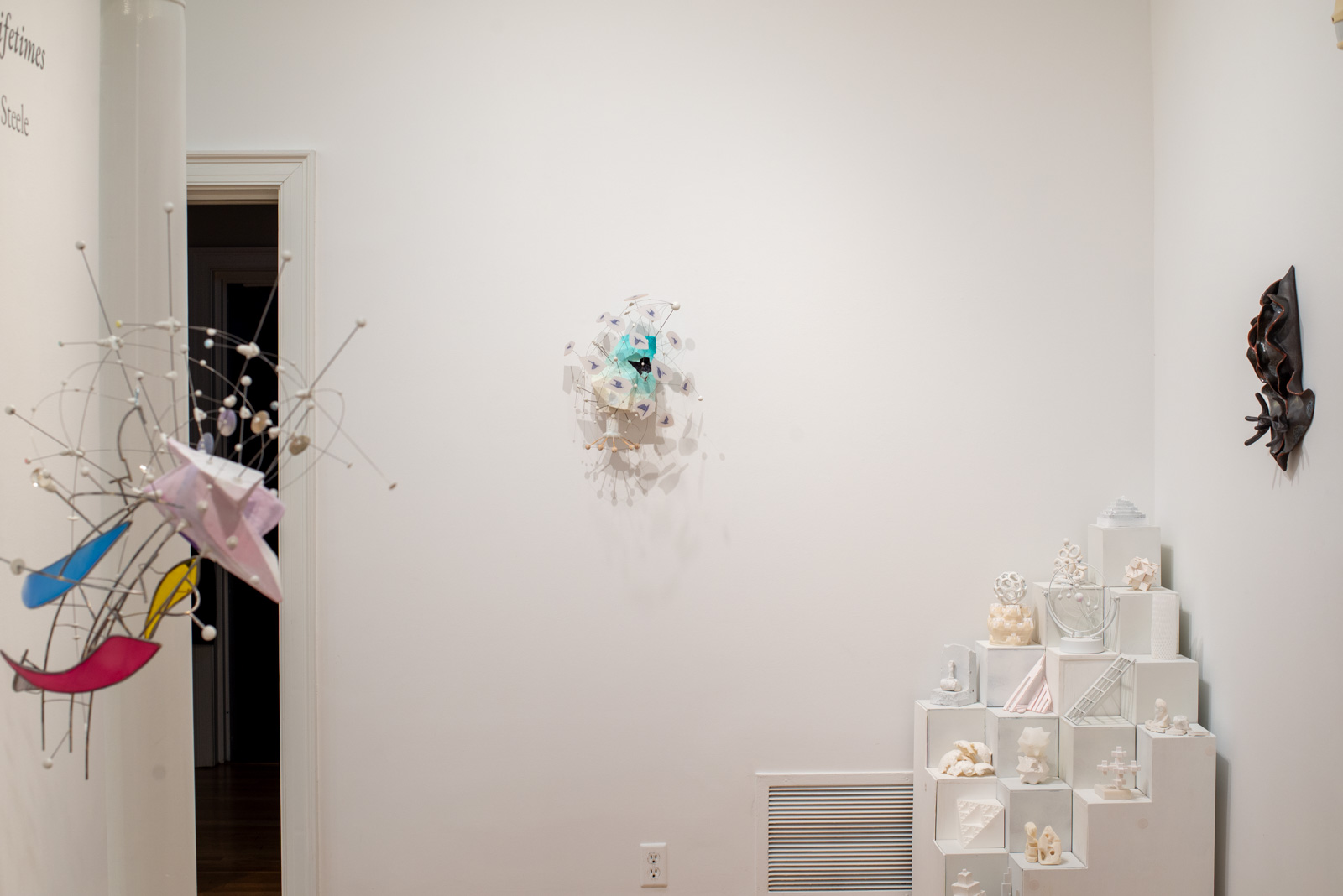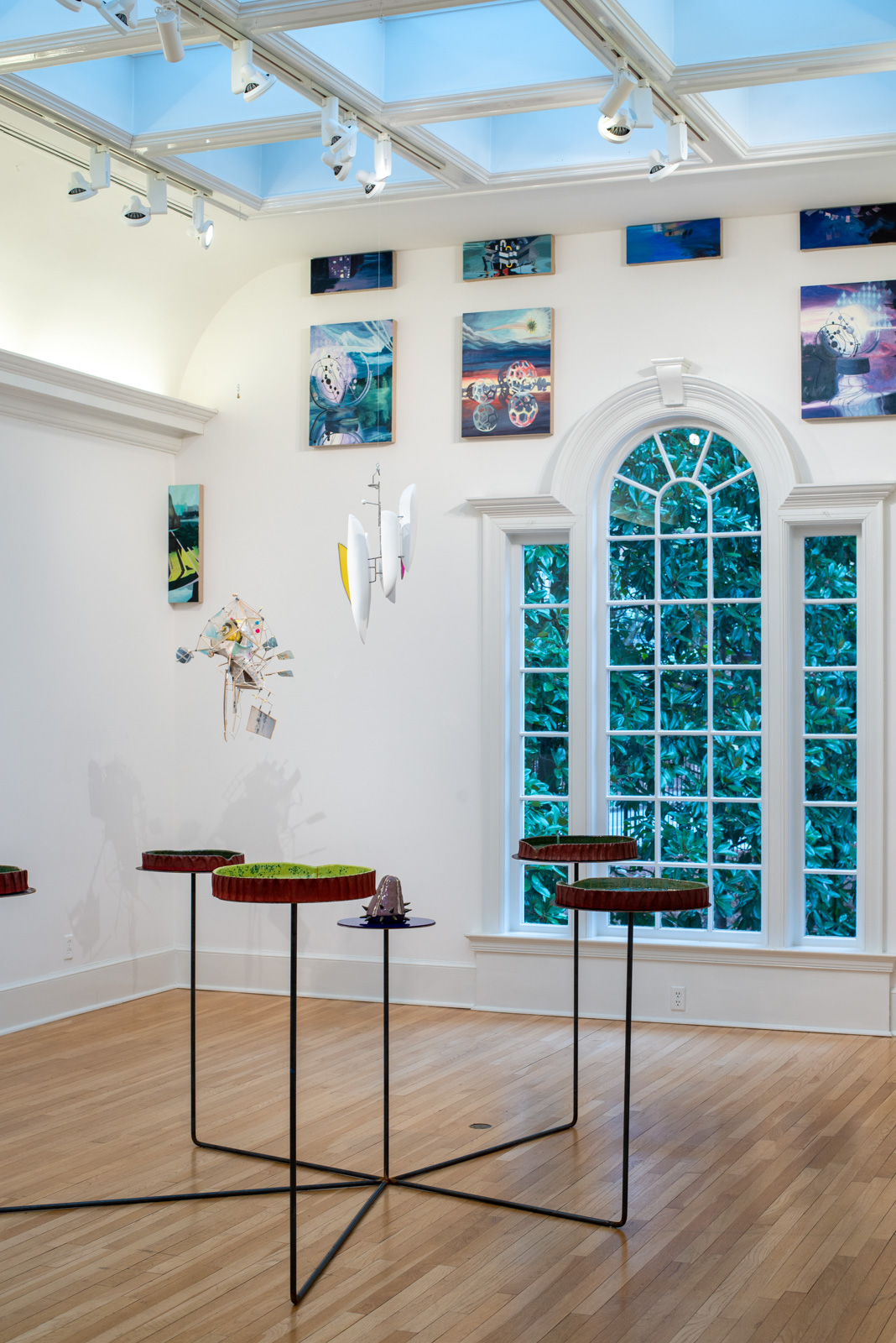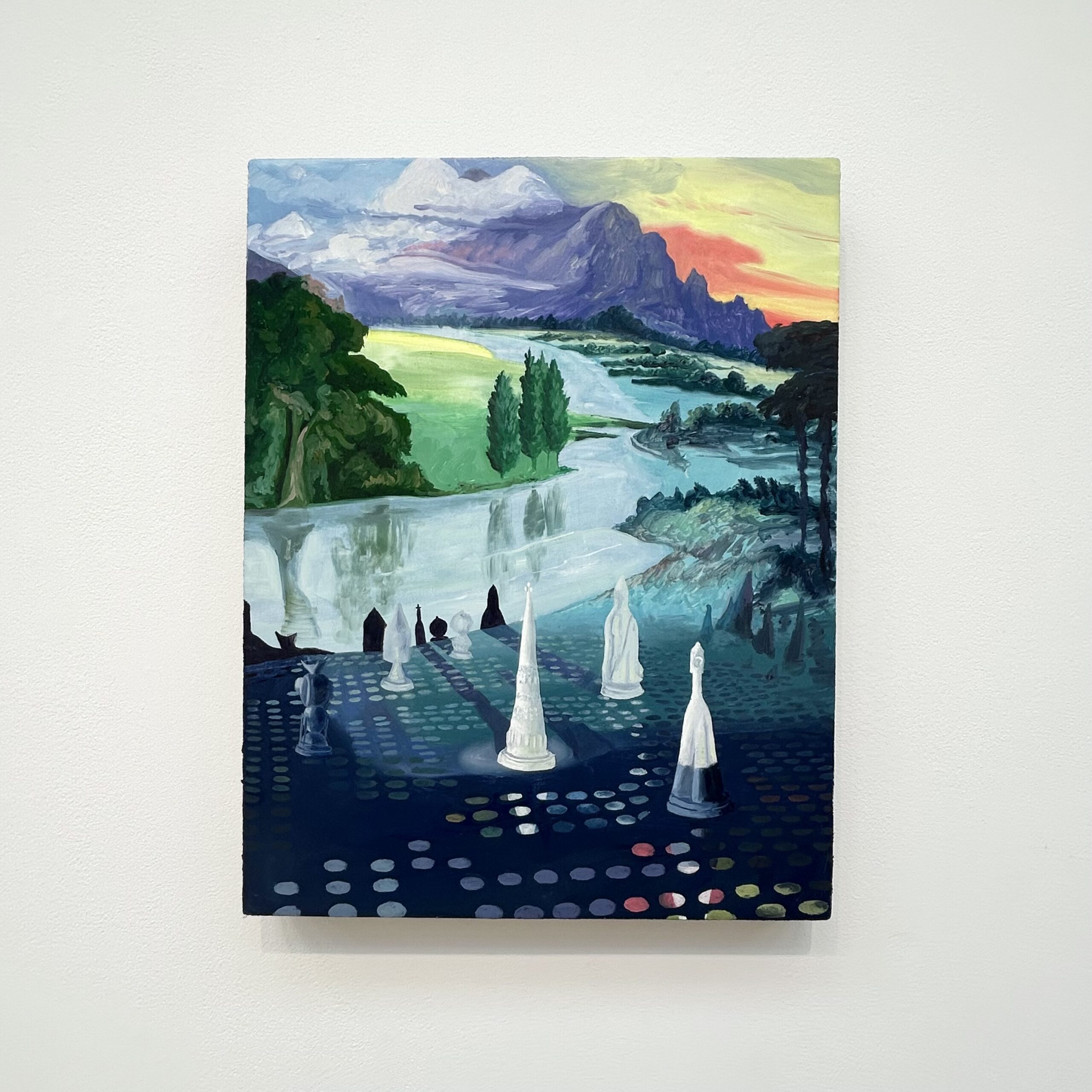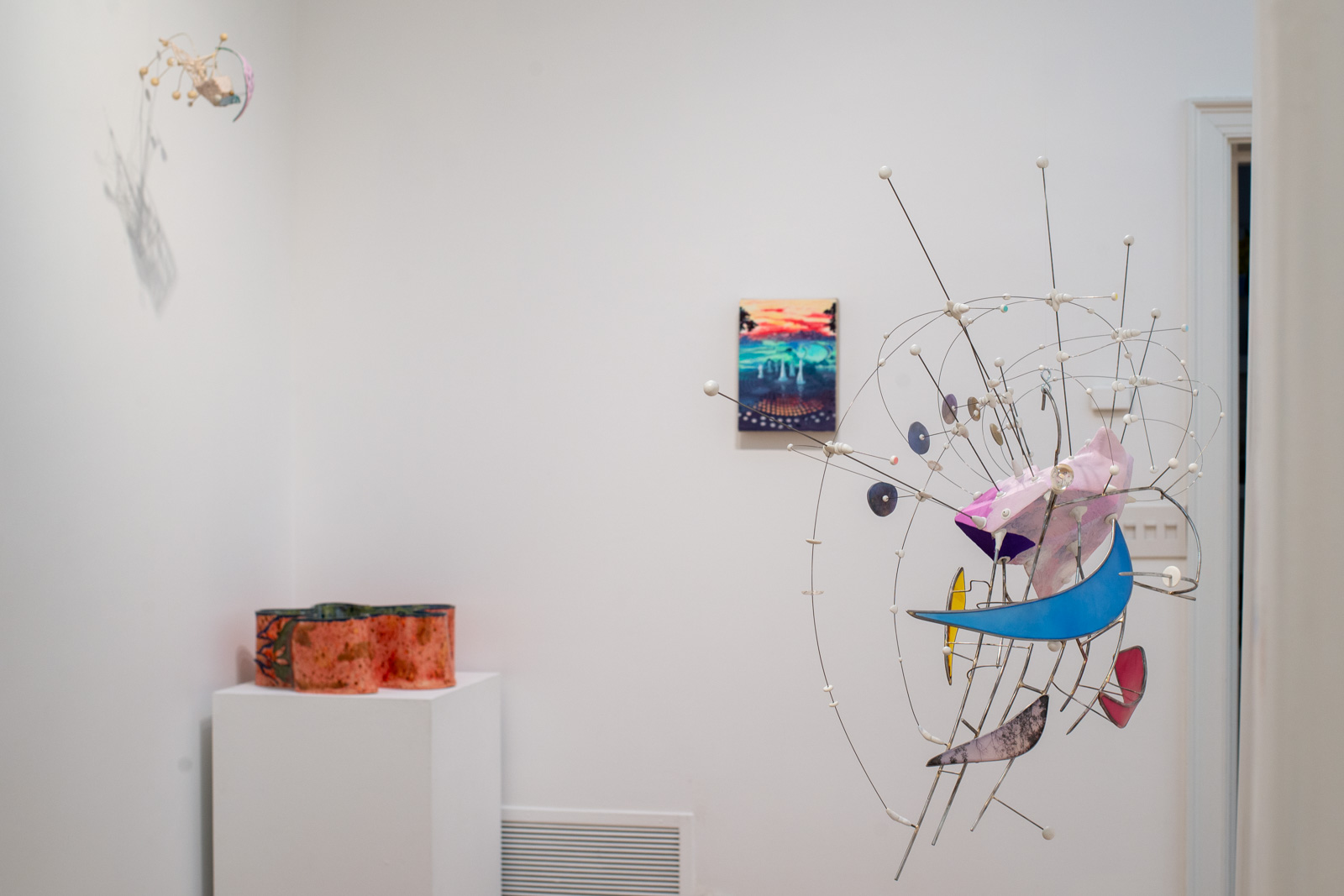They Will Not Complete It In Their Lifetimes
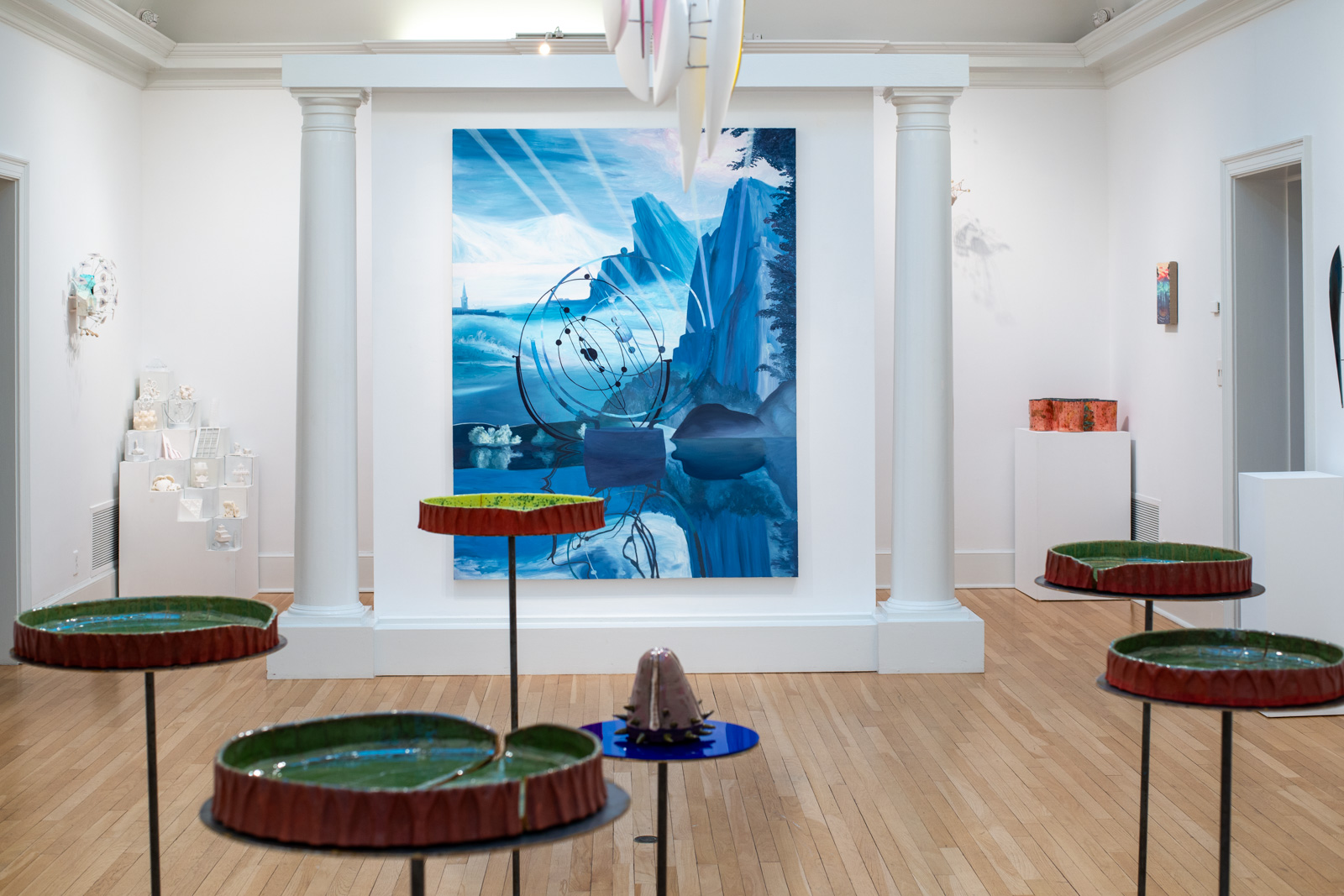
They Will Not Complete It in Their Lifetimes, installation view, 2025 [photo: Emily Llamazales; courtesy of the artist and Swan Coach House Gallery, Atlanta]
Share:
They Will Not Complete It in Their Lifetimes, installation view, 2025 [photo: Emily Llamazales; courtesy of the artist and Swan Coach House Gallery, Atlanta]
A speculative past, present, and future collide in They Will Not Complete It in Their Lifetimes (February 20–March 20, 2025) at Swan Coach House Gallery. Featuring the work of Emily Llamazales, Aaron Kagan Putt, and Ben Steele, the exhibition gushes with a fervor of meticulous world building and model making, allowing the works to breathe and take on a life of their own. An eclectic energy unites them in the gallery, yet each artist’s work visually bounces with color, texture, and form that gives off a certain palpability.
Emily Llamazales, Cerise on the second day, 2025, Glazed stoneware, steel, acrylic plexiglass mirrors, 86 x 105 x 43 inches [photo: Emily Llamazales; courtesy of the artist and Swan Coach House Gallery, Atlanta]
Seashells embedded in ceramic forms reminiscent of horseshoe crabs and other living fossils offer a glimpse of what could be, or could have been, in Llamazales’ work. Her mashup of organic and inorganic textures is affixed to the walls with steel screws. The ceramic-plastic-metal fusion of these forms gives the impression of morphing, reacting, pulsating, wetness—almost of life. Notably, Cerise on the second day (2025) has large metal structures balancing ceramic lily pads, interiors deep green, and a single lily pad emanating a bespeckled, radioactive palette of colors. The lily pads give the impression of floating. It’s as if the air gets thicker, the gallery becomes a sunken garden. Tell me, did the image come up from inside me, of its own accord? (2025) hangs with a trail of ceramic forms shaped like leaves or dividing cells; above them, an image of red lichen proliferating. Llamazales’ work abounds in rich patterns and textures, the works lifelike, bodily, visceral.
Emily Llamazales, the new flesh, 2023, Glazed stoneware, shells, acorn nuts, glass bead gel, 18.5 x 15 x 3 inches inches [courtesy of the artist and wan Coach House Gallery, Atlanta]
Aaron Kagan Putt, Untitled (For the Birds), 2024, plaster, aqua resin, wire, wood, foam, photographs cast in resin, 19 x 16 x 10 inches [courtesy of the artist and wan Coach House Gallery, Atlanta]
If Llamazales offers something to the exhibition that feels biological and vivacious, Putt introduces an elemental, modular constituent to those organisms. Putt’s work—hanging mobiles and wall mounted sculpture—is something to explore. Together, they form constellations made from small bits of information and material held together by wooden and wired lattices. The mobiles are embedded with images, fragmented scenes, individually incomplete, but they come together to create a unique, hybridized totality. One can find alligator clips, bright dots of color, bits of clay, and even resin-encased insects in the works—a wide-ranging mix of organic and inorganic components. Stretching across some segments are photographs—stills of everyday life: a person’s shadow, plots of land from an aerial view, a hand resting on an arch. They anchor the abstract elements to recognizable scenes.
From its colorful center (a nucleus, so to speak), Untitled (for the Birds) (2024) radiates images of a bird in flight, with subtle variations of the wings lending motion to this otherwise static work of art. The conglomeration of these elements into forms that recall molecular structures was disorienting—my sense of scale fluctuated. In its entirety, the work resembles something tiny, imperceptible, universal, but closer inspection brings forth specific and even intimate scenes, as if complex information or blueprints were encoded into these structures. They hold a sort of DNA for the world around them.
Ben Steele, Searching for Alignment, 2024, Oil on canvas, 76 x 58 inches [photo: Emily Llamazales; courtesy of the artist and wan Coach House Gallery, Atlanta]
In contrast to the other artists’ organic and molecular forms, Steele’s work serves as a backdrop—that is, a setting, a place. Scenes depict a series of worlds, or possible futures where rockets, planetariums, and monuments reside, devoid of any perceptible life, set in dreamy landscapes. At times resembling illustrations from a science-fiction epic, such as H.G. Wells’ The Time Machine, the paintings convey a masterly control of the medium and a deep appreciation for the history (and perhaps future) of landscape painting. Alongside Steele’s realistic renderings of machine and architectural structures, one can find Future Objects (2025), an installation of miniature 3-D maquettes that depict the same architectures. Looking at the miniatures adds another layer through which to interpret the paintings, a simultaneity of the structures existing in the gallery (not to mention the world at large) as well as the painting. This process of building miniatures and then recreating them, pictorially, in the paintings creates a dissonance between actuality and possibility. The works reimagine or reinterpret themselves across space and time, in a gesture not too dissimilar from Putt’s birds. These works speak to painterly sensibilities—of painstaking detail, and of broad, gestural strokes that create backgrounds, reflections, or the wispy nature of leaves blowing on a tree.
They Will Not Complete It in Their Lifetimes, installation view, 2025 [photo: Emily Llamazales; courtesy of the artist and Swan Coach House Gallery, Atlanta]
They Will Not Complete It in Their Lifetimes, installation view, 2025 [photo: Emily Llamazales; courtesy of the artist and Swan Coach House Gallery, Atlanta]
They Will Not Complete It in Their Lifetimes carries a majestic air throughout, like reflections of the world held in suspended animation. It’s electric, jumping from each artist’s work, between the various materials and representations, yet they unite in their futurity to prompt questions: What will remain of us, and what transcends understanding? These objects are recognizable, but they’ve also been transformed, leaving viewers with a visionary interpretation of the future.
Ben Steele, Rocket Summer 2, 2024, Oil on linen on panel, 18 x 14 inches [courtesy of the artist and Swan Coach House Gallery, Atlanta]
They Will Not Complete It in Their Lifetimes, installation view, 2025 [photo: Emily Llamazales; courtesy of the artist and Swan Coach House Gallery, Atlanta]
Noah Reyes is an artist taking steps in many different directions, resulting in an awkward dance between curating, writing, and artmaking. Reyes works for Art Papers, serves as a board member for Lostintheletters, and sometimes writes for ArtsATL, ART PAPERS, Burnaway, and IMPACT Magazine.
